
 |
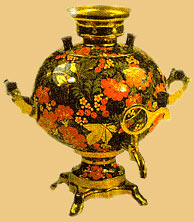 Samovar
(Tea-urn) is a purely Russian invention. Its origin is connected
with tea. Tea was delivered to Russia from the territory of West Mongolia
in the 17-th century and was used as medicine among the nobility. Samovar
(Tea-urn) is a purely Russian invention. Its origin is connected
with tea. Tea was delivered to Russia from the territory of West Mongolia
in the 17-th century and was used as medicine among the nobility.Tea was a competitor of sbiten, the most favourite drink in Russia. Its components are: hot water, medical herbs and honey. The samovars became the symbol of Russian hospitality and family comfort as well as the sign of prosperity. It remains most stable attribute of domestic coziness. Step by step a peculiar ritual of tea-drinking emerged and was adopted in every Russian homse. In compliance with it, a hostess or her elder daughter poured the tea. Some families held two samovars, one, more plain, for everyday use, and a dearer one - for receptions and festivities. There were homes with separate samovar-rooms whose interior was crowned by the samovar. |
|
|||
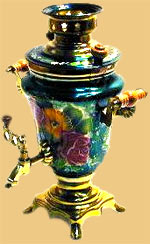 Russian
samovars vary in interior construction and exterior decoration and
purpose. Samovars came in various shapes and sizes depending on their
use. Most were small, around 18 inches high, and were used in homes
and offices. Larger samovars could be several feet in hight and diameter.
Traveling samovars were equipped with handles and removable legs.
Others had compartments for preparing food. The metalworkers of the
Russian samovar factories provided exquisite detail in silver, silver
plating on copper, bronze, copper, steal, cast iron. Russian
samovars vary in interior construction and exterior decoration and
purpose. Samovars came in various shapes and sizes depending on their
use. Most were small, around 18 inches high, and were used in homes
and offices. Larger samovars could be several feet in hight and diameter.
Traveling samovars were equipped with handles and removable legs.
Others had compartments for preparing food. The metalworkers of the
Russian samovar factories provided exquisite detail in silver, silver
plating on copper, bronze, copper, steal, cast iron. Tula samovars were spread all over Russia. At the fairs there were sold samovars of different shapes: vase-shaped, pear-shaped, wine-glass-shaped and others. Samovars are a necessary feature of the Russian mode of life and consequently a part of Russian applied art. Among monuments of folk domestic art samovars occupy specific place. They may be considered not only as domestic utensils, some of them are real works of applied arts. Each true master wanted to astonish the customers be their creative fantasy. |
||||
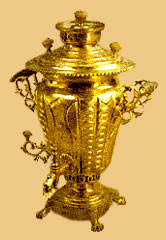 The
earliest samovars resembled English tea urns or tea vessels. Later,
at the end of eighteenth century, samovars began resembling vases
and antique urns. The
earliest samovars resembled English tea urns or tea vessels. Later,
at the end of eighteenth century, samovars began resembling vases
and antique urns. Strict design, durability in combination with decorative
qualities caused interest to samovars on the part of the people
all over the world. |
||||
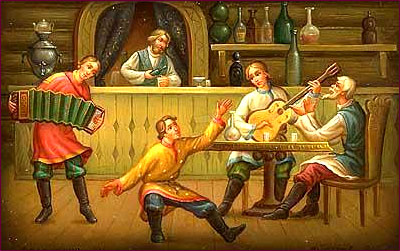 "At the Tavern", Fedoskino School of painting. Every samovar with hand painting has it's own style and is not only article of arts and crafts, but also a good remembering gift. Modern day Russians still use the samovar quite often. However modern technology has provided for electric samovars which don't require the use of charcoal. As in old, these samovars are found in kitchens, offices, and even on Russian Trains. And the use of the samovar has spread from Russia to much of eastern Europe. |
||||
icons | matreshka | samovar | zhostovo trays | lacquerwork | traditional dress | soviet era |
||||
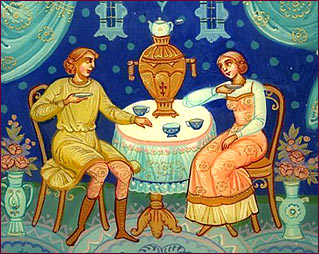
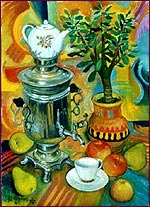 A
bit of a History
A
bit of a History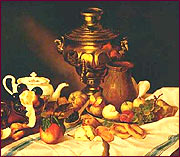 Samovars
were made from cupronic-kel, red and green copper, pinchbeck,
in some cases - from silver. Sometimes they were plated with
gold, silver, but basic metal was always - brass. In the course
of centuries samovar shapes changed. By the end of the 19-th
century their quantity reached 165. It was almost impossible
to mechanize samovars manufacture completely. Tools were also
unchanged. By hand assembly five-six samovars per day were
produced. The highest peak of samovar manufacture in Tula
is related to the 80s of the 19-th century.
Samovars
were made from cupronic-kel, red and green copper, pinchbeck,
in some cases - from silver. Sometimes they were plated with
gold, silver, but basic metal was always - brass. In the course
of centuries samovar shapes changed. By the end of the 19-th
century their quantity reached 165. It was almost impossible
to mechanize samovars manufacture completely. Tools were also
unchanged. By hand assembly five-six samovars per day were
produced. The highest peak of samovar manufacture in Tula
is related to the 80s of the 19-th century.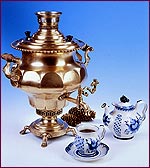 Prices
reduction in the process of manufacture caused standardization
of samovar shapes. The so-called cylindrical samovars were
widely spread.
Prices
reduction in the process of manufacture caused standardization
of samovar shapes. The so-called cylindrical samovars were
widely spread.